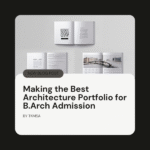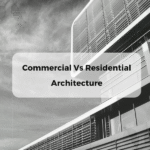“College was especially sweet because of the positive, hopeful atmosphere of a college campus.”
- Jerry Kramer
Campus design concepts used in colleges and universities impact the learning experience of students significantly. Well-designed campuses not only promote a positive atmosphere but also foster collaboration, creativity, and academic success.
The design philosophy of the TKM School of Architecture (TKMSA) emphasizes the practical education of design methodologies. Read on to understand how focusing on campus architecture design ideas can help create campuses that meet diverse needs and foster educational experiences.
The Evolution of Campus Architecture
Types of campus architecture have evolved from traditional to modern because of several factors, such as
- technological advancements
- evolving student needs
- a greater focus on inclusivity and sustainability
The following are some of the major traits of traditional campus architecture design ideas:
- Focus on architectural styles and aesthetics
- Fixed layouts for classrooms
- Limited integration of technology
- Passive building designs with limited natural ventilation and light
Modern campus architecture design ideas focus on creating a student-centric environment that is vibrant and smart. This includes:
- Student-centric spaces to accommodate the various needs of students.
- Integration of smart technology solutions like digital learning platforms and interactive classrooms
- Sustainability and inclusivity to make campuses eco-friendly and accessible to all
- Data-driven management to improve student engagement and optimize space utilization
- Flexible learning spaces to conform to diverse methods of teaching and learning
- Connection to nature with large windows, open floor plans, and transparent facades
Further, modern campuses integrate student-centric spaces that focus on sustainability and technology. These spaces are characterized by:
- Renewable Energy
- Green Spaces
- Energy Efficiency
- Locally-sourced Building Materials
- Smart Infrastructure
- Digital Learning
- Mobile Learning
- Collaboration Tools
- Flexible Learning Environments
- Well-being Spaces
- Inclusive Design and
- Community Spaces
Core Principles of Effective Campus Design
- Functionality & Flexibility
Adaptable spaces are inevitable for functionality and flexibility in campus architecture design ideas. These spaces help accommodate the evolving needs, user groups, and technologies.
Adaptable spaces also ensure the sustainability and long-term usability of buildings. Some common examples of flexible spaces in college campuses include
- Flexible Classrooms
- Multi-Purpose Lounges
- Modular Furniture and Systems
- Adaptable Technology Infrastructure
- Open-Plan Offices and
- Collaboration Zones
- Connectivity & Accessibility:
Campus architecture design ideas should foster an equitable, vibrant, and welcoming environment for all faculty, students, and staff. Seamless movement ensures physical accessibility, while inclusivity builds a sense of belonging and promotes social integration.
These specific design elements in a college campus can enhance the overall experience of learning and working:
- Universal design principles:
- Wayfinding systems and tactile paving
- Accessible elevators and ramps
- High-contrast lighting and signage
- Sensory-friendly design
- Culturally relevant design
- Accessible restrooms
- Adaptable and flexible spaces
- Sustainability:
Integration of energy-efficient systems and eco-friendly materials into campus design concepts is crucial for long-term social, environmental, and economic benefits. These elements create more attractive and healthier spaces while saving money.
Some of the most sustainable design strategies include
- Water conservation
- Energy efficiency
- Green spaces and
- Sustainable materials
Also read: Sustainable Architecture Firms in India: List of Top 10 for You
- Aesthetic Appeal
Aesthetically appealing spaces can create a positive and inspiring learning environment. Hence, they improve the comfort and academic performance of students significantly.
These spaces can also promote engagement, collaboration, and creativity and develop a sense of community and belonging. The following are a few considerations for campus architecture design ideas while you focus on aesthetic appeal:
- Incorporate natural elements
- Use local art and materials.
- Create inclusive spaces:
- Balance aesthetics and functionality
TKMSA’s Campus: A Living Laboratory for Campus Design
The campus of TKM School of Architecture (TKMSA) extends across the 35-acre Musaliar Hills at Karuvelil in Kollam. It has a design that blends well with its natural surroundings. This is a detailed look into the peculiar campus architecture design ideas you can find at TKMSA:
- Sustainable and Natural Elements
- Emphasis on Natural Light and Ventilation: Design studios with maximum natural light and ventilation for comfortable and energy-efficient learning.
- Integration with the Landscape: A natural setting amidst greenery and trees is another peculiarity of the college campus architecture design concepts used in TKMSA’s construction.
- Modern and Functional Design
- Advanced facilities: design studios with smart boards, pin-up panels, and modern furniture
- Innovation and digital learning: Students can explore new possibilities in design with virtual reality, Building Information Modeling (BIM), parametric design, and other advanced tools.
- Collaborative spaces: These spaces allow students and faculty to interact and share knowledge.
- Focus on Design and Creativity
- Studio Design: Flexible and adaptable studio spaces for student projects, accommodating different designs.
- Research and Innovation: The campus architecture design ideas in the TKMSA campus promote innovation and research with an emphasis on emerging technologies and sustainable architecture.
Also read: How TKMSA Became the Best Architecture College in Kerala?
Case Studies: Exemplary Campus Architecture
The following are some of the most remarkable campus architecture examples around the world:
The Senate House at the University of Madras blends Islamic, Indian, and Gothic elements to exemplify Indo-Saracenic architecture. The distinctive campus architecture design ideas to take from this piece of architecture are
- Pointed Arches
- Intricate Carvings
- Central Dome
- Ornate Balconies
- Minarets
- Stained Glass
- Earthy Tints
- High Ceilings
- Porticos
- Brick Shells and Lime Mortar
- Geometric Patterns and
- Double-Floor High Verandas
These design elements create a unique and memorable structure for the campus while combining with its strategic layout and location.
- RMIT Building 220:
This educational building at the Bundoora campus is one of the best models for campus architecture design ideas, combining modernity with the use of innovative materials. The following are some significant elements of design:
- Modern and bold texture with an arc-shaped structure
- Innovative use of metal and concrete for an eye-catching aesthetic
- A form in union with the datum level of the university
- Incorporation of sustainable elements such as double-skin facades and green walls.
- A design promoting integration with its natural environment
- Tocal College:
Tocal College’s campus has made use of traditional architectural forms and local materials to associate with its rural context. Key campus architecture design ideas to take include
- Locally sourced materials
- A form reminiscent of traditional Japanese architecture
- Quadrangle Layout
- Colonnades and Courtyards
- Buildings retaining unique structural expression and character
Integrating Campus Design Concepts into the B.Arch Curriculum
The B.Arch curriculum of TKMSA is planned to equip students with the practical skills and knowledge to form university campus design concepts that incorporate
- sustainable design
- urban planning
- technological integration
The curriculum promotes these aspects by:
- Focusing on environmental factors such as material selection, site conditions, and climate.
- Teaching students to create campus architecture design ideas for accessibility
- Encouraging students to promote responsible and sustainable practices in their design choices
- Creating opportunities to explore innovative solutions and sustainable design principles
- Imparting deep insights into diverse socio-cultural contexts
- Promoting community-focused campus architecture design ideas
- Encouraging multidisciplinary teamwork
- Encouraging students to use technological solutions and design tools
- Incorporating design studios, design reviews, thesis projects, and practical experience.
- Employing resources like advanced facilities, experienced faculty, and a collaborative learning environment.
TKMSA helps students bridge theory with real-life designing of university campuses with a multi-faceted approach that includes:
- Workshops
- Site visits
- Design studios
Further, students’ projects showcase innovative design proposals for colleges by students.
Also read: What Aspiring Architecture Students Can Expect in Their First-Year Studio
Future Trends in Campus Architecture
Some future trends in campus architecture design ideas include
- Smart campuses
- Adaptive reuse of existing structures
- Biophilic designs
- Smart Campuses:
Campus architecture design ideas are increasingly employing smart technologies to revolutionize educational spaces. These ideas emphasize smart infrastructure and data-driven insights.
Smart campuses mainly aim to make the learning atmosphere more connected and responsive. Artificial intelligence (AI), the Internet of Things (IoT), and AR/VR are some examples of the advanced technologies being used on these campuses.
Smart campuses also use energy monitoring systems, intelligent lighting, and digital wayfinding technologies to optimize operating efficiency.
- Adaptive Reuse:
Adaptive reuse of existing structures for modern requirements enables expansion cost-effectively and sustainably.
The following are some of the adaptive reuse examples for campuses:
- Repurposing old dormitories into academic buildings
- Converting former factories to art studios
- Repurposing historic libraries into community centers
- Restoring deserted buildings as student housing
- Biophilic Design:
Biophilic elements in campus architecture design ideas connect people and nature even in a built environment. These factors enhance occupants’ productivity, well-being, and contentment.
Some biophilic college campus design concepts include:
- Green roofs and green walls
- Natural ventilation and lighting
- Water features like ponds and fountains
- Use of natural materials
- Designated outdoor spaces for relaxation, learning, and recreation
Conclusion
Innovative campus architecture design ideas have diverse significance in today’s competitive landscape for academic institutions. It enhances the academic performance and experiences of students.
Visionary campuses also foster community building effectively. Further, innovation in campus architecture design ideas also attracts superior talents to a university by boosting its reputation.
TKMSA fosters a culture of sustainability, technology integration, and interdisciplinary learning to lead the education of campus architecture design ideas. We prepare our students for real-world architectural projects by integrating collaborative learning and technological solutions into our curriculum.
Our students are also encouraged to address prospective challenges in the evolving architectural profession. We invite prospective students to check out our website at https://tkmsa.ac.in/ to learn about our B.Arch program and other facilities that could help you create world-class campus design concepts worldwide.
To know more, contact us at:
- Phone: 0474-2731021
- Email ID: tkmtrust@yahoo.com




